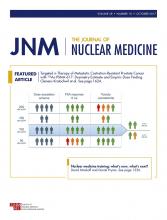TO THE EDITOR: Zhang and colleagues recently published their interesting work in The Journal of Nuclear Medicine (1). Both integrin αvβ3 and gastrin-releasing peptide receptors are important markers in the biology of cancer as evidenced by the plethora of such PET radiopharmaceuticals, including arginine-glycine-aspartate (RGD) peptides for imaging angiogenesis (2) and bombesin analogs for imaging gastrin-releasing peptide receptors (3).
Although the use of RGD PET radiopharmaceuticals in prostate cancer is limited (4), bombesin analogs have been used successfully in this disease (5,6). We now know the expected biodistribution of the two classes of PET radiopharmaceuticals when injected separately. Therefore, in reviewing the methods and results reported by the authors, one may notice an incomplete evaluation of the new radiotracer because a comparison was not made with the 68Ga-RGD injected separately. RGD dimers have normal distribution in the choroid plexus and thyroid gland (7), which is not observed in the images published for 68Ga-bombesin-RGD. Can this be an indication that the new tracer may behave differently from the two injected separately? Our group uses the combined administration of 18F-FDG and 18F-NaF for detection of skeletal lesions. However, we compared the combined scan with both 18F-FDG and 18F-NaF in each participant included in the protocols before concluding that the combined scan provides similar information (8). A similar scrutiny should be the authors’ goal for future use of 68Ga-bombesin-RGD.
More importantly, readers may have difficulty identifying the optimal clinical use of 68Ga-bombesin-RGD. Both angiogenesis and gastrin-releasing peptide receptors can be targets for therapies such as bevacizumab or 177Lu-labeled bombesin analogs (9), respectively. How would a treating physician decide on the use of one versus the other based on a 68Ga-bombesin-RGD PET scan? How would a theranostics approach be possible?
Lastly, the important task of identifying disease heterogeneity within patients will not be possible using 68Ga-bombesin-RGD PET. Clinicians need to know whether all or what lesions demonstrate increased angiogenesis versus gastrin-releasing peptide receptor expression.
We are now fortunate to have multiple targets for detection and treatment of prostate cancer (10). Although the appropriate use of each class of PET radiopharmaceutical still needs to be evaluated in this disease, the information about cancer biology that each provides is of high merit. Bundling such information in a single examination may negate its usefulness. To quote from an editorial that accompanied our previous published work, technical feasibility versus clinical utility may be a question of “can we?” versus “should we?” (11)
Footnotes
Published online Mar. 9, 2017.
- © 2017 by the Society of Nuclear Medicine and Molecular Imaging.







